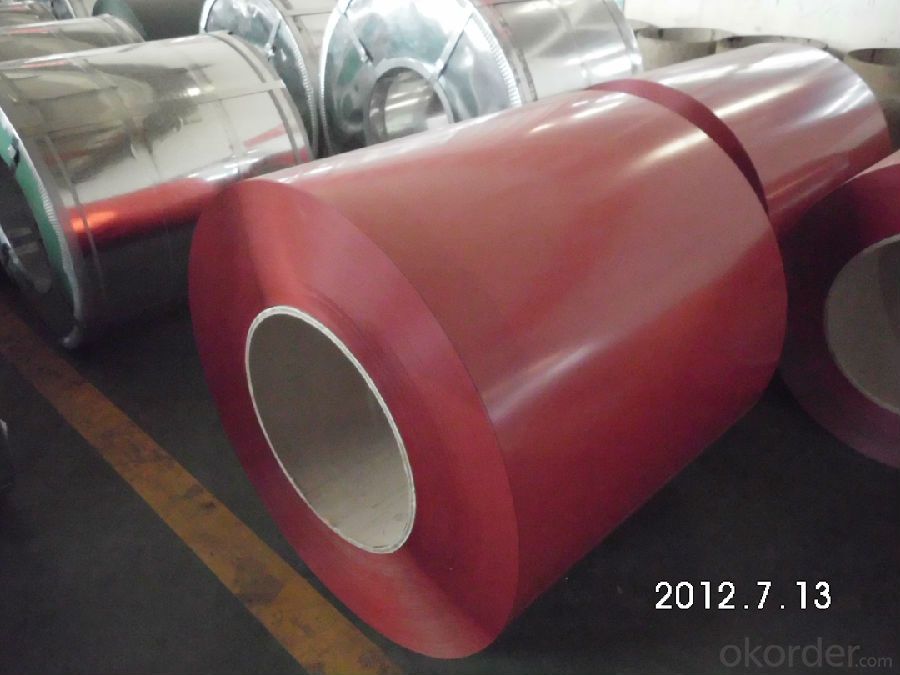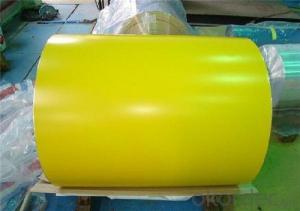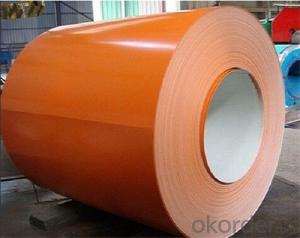RAL Scale Z30 Prepainted Rolled Steel Coil for Construction Roofing
- Loading Port:
- Shanghai
- Payment Terms:
- TT OR LC
- Min Order Qty:
- 50 m.t.
- Supply Capability:
- 28000 m.t./month
OKorder Service Pledge
OKorder Financial Service
You Might Also Like
Structure of RAL Scale Z30 Prepainted Rolled Steel Coil for Construction Roofing

Description of RAL Scale Z65 Prepainted Rolled Steel Coil for Construction Roofing
Prepainted Rolled steel Coil is a kind of coated steel coil/sheet. With the cold rolled steel of different strength and thickness as substrate, it is produced through applying Al-Zn coat on both faces by hot dip process. In its coating, Al accounts for about 55%, Si 1.6%, while the remaining is Zn. Aluminum zinc coils enjoys both the physical protective feature and durability of Al and the electrochemical protective property of Zn. And its surface has bright silver color and regular embossed-like figure, which are highly decorative.
Main Feature of RAL Scale Z30 Prepainted Rolled Steel Coil for Construction Roofing
1.Corrosion resistance: It mainly depends on the aluminum protection. When the zinc being worn, the aluminum will form a dense layer of aluminum oxide, resist corrosion material to prevent further corrosion inside.
2. Heat resistance: Aluminum zinc alloy steel sheet has excellent heat resistance, can withstand high temperatures over 300 centigrade, and is similar with aluminized steel high temperature oxidation resistance. It often used in chimney pipes, ovens, fluorescent lighting device and the device cover.
3. Heat reflective: Galvanized steel plate heat-reflective high rate is twice as galvanized steel, often used to make insulation materials.
4. Economy: Because density of 55% AL-Zn is smaller than the density of Zn, so in the same weight and thickness of Galvanized zinc layer, aluminum-zinc steel plate is larger area more than 3% of galvanized steel sheet.

Applications of RAL Scale Z30 Prepainted Rolled Steel Coil for Construction Roofing PPGI is featured with light- good looking and anticorrosion. It can be processed directly, mainly used for construction industry, home electronic apparatus industry, electronic apparatus industry, furniture industry and transportation.It is ideal for a wide range of applications,, such as pre-engineered buildings, architectural panels, roofing, siding, cladding, and many other building components.and also used back plate of appliance; wide range of construction, furniture industry, transportation industry, etc.
 Specifications of RAL Scale Z30 Prepainted Rolled Steel Coil for Construction Roofing
Specifications of RAL Scale Z30 Prepainted Rolled Steel Coil for Construction Roofing
Product | RAL Scale Z30 Prepainted Rolled Steel Coil for Construction Roofing |
Material Grade | SGCC / SGCH / DX51D+AZ, etc |
Thickness | 0.2-3.0mm |
Width | 600-1500mm |
Tolerance | Thickness: +/-0.02mm , Width:+/-2mm |
Zinc-coating | AZ40-150g/m2 |
Technique | Raw material: Hot rolled steel coil --> Cold rolled_>hot dipped galvalume |
Surface | Dried, Chromated, Unoiled |
Spangle | Regular spangle , small spangle, zero spangle |
ID | 508MM 610MM |
Coil weight | 25MT max |
Export package | Cardboard inner sleeves, Waterproof paper, galvanized steel covered and steel strip packed |
FAQ of RAL Scale Z30 Prepainted Rolled Steel Coil for Construction Roofing
We have organized several common questions for our clients,may help you sincerely:
1. What is the minimum order quantity ?
Our MOQ is 50mt for each color. And we could give more discount if you make big order like 1000 tons and more. Further more, the more appropriate payment term your can offer the better price we can provide.
2. How long can we receive the product after purchasing?
Usually within thirty working days after received buyer’s advance payment or LC. We will arrange the factory manufacturing as soon as possible. The cargo readiness usually takes 15- 25 days, but the shipment will depend on the vessel situation.
3. What is your package of the products?
Package: Sea worthy Export Packing Standard export and seaworthy packing. (waterproof paper and metal sheet protection with fluted rings at inner and outer edges, 4 eye bands and 4 circumferential bands fasten the coil)
- Q:What are the different coil cutting methods used for steel coils?
- There are several different coil cutting methods used for steel coils, including slitting, shearing, and laser cutting. Slitting involves using circular blades to cut the coil into narrower strips. Shearing involves using straight blades to cut the coil into desired lengths or shapes. Laser cutting, on the other hand, uses a high-powered laser beam to precisely cut the steel coil into specific shapes or patterns. Each method offers its own advantages and is chosen based on the desired outcome and requirements of the steel coil cutting process.
- Q:How are steel coils inspected for surface defects after processing?
- Steel coils are inspected for surface defects after processing through visual inspection, magnetic particle inspection, or ultrasonic testing. Visual inspection involves examining the surface for any visible defects such as scratches, dents, or corrosion. Magnetic particle inspection uses magnetic fields and iron particles to detect surface cracks or defects that may not be visible to the naked eye. Ultrasonic testing involves using high-frequency sound waves to detect internal and surface defects in the steel coils. These inspection methods help ensure the quality and integrity of the steel coils before they are further processed or delivered to customers.
- Q:What are the different methods of painting steel coils?
- Painting steel coils can be achieved using various methods, each with unique benefits and practical applications. 1. Coil coating, an automated and continuous process, unwinds, cleans, pretreats, primes, paints, and cures the steel coils before rewinding them. This method guarantees precise paint application control and ensures a consistent finish. It is widely employed in high-volume production for industries like automotive and construction. 2. Spray painting, a versatile and flexible method, involves manually or mechanically spraying paint onto the steel coils. It allows for customization and precise control over the paint application. Depending on the desired finish and project requirements, spray painting can be done using techniques like airless spraying or electrostatic spraying. 3. Dip coating, also known as immersion coating, immerses the steel coils into a paint tank, ensuring complete coverage of all surfaces. This method is suitable for large or bulky steel coils that are not easily spray painted. Dip coating provides excellent coverage and is commonly used in applications like the electrical or appliance industry. 4. Powder coating, an electrostatic process, applies dry powder paint to the steel coils. Charged powder particles adhere to the grounded coils, creating a durable and even coating. This method offers superior resistance to impact, chemicals, and UV rays. It is frequently utilized in industries requiring high-quality and long-lasting finishes, such as aerospace or outdoor equipment. 5. Roll coating passes the steel coils through a series of rollers partially submerged in paint. As the coils move through the rollers, the paint is transferred to their surface. Roll coating is preferred for thin or delicate steel coils, as it provides a gentle and uniform paint application. It is commonly used in the appliance or electronics industry. Each method has its advantages and is selected based on factors like desired finish, production volume, cost, and project-specific requirements. Ultimately, the choice of painting method depends on achieving the optimal balance between quality, efficiency, and cost-effectiveness.
- Q:who are the 7 best steel guitar players ever?
- I would have to put Lloyd Green and Buddy Emmons at the top of the list for virtuoso instrument playing mastery, technical expertise and versatility, adapting steel guitar to most any kind of music they were in studio to lay tracks for. Certainly, Pete Drake, and Weldon Myrick belong at the top of the best of the Nashville Session steel players for the last 50 years or more. While Leon McAuliffe and Roy Wiggins in the 1930's and 40's pioneered and paved the way for the country music steel guitarists coming along in the 50's 60's; we cannot leave this list without crediting the virtuoso technical and musical versatility of much later steel guitarists, whom have been the top-drawer, first-call session players in Nashville studios for the last 30 years or so. Namely, the best of the Nashville Session Steel players: Paul Franklin Jr. That's how my votes would stack-up, of the 7 best steel guitar players, ever! Thank you for a fun question to muse over and answer! Sincerely, Jazz Me109 PS: When editing what I've written above, I found it amusing and quite interesting that Paul Franklin, Jr. wound-up at the bottom of my list, when indeed he should be at the top of the list! I guess I feel that way about all of the steel guitar masters, that I've listed here, though! Oh well!...Have a great day! :)
- Q:Please people suggest me how can I select external finishing for Steel Building as there is a wide range of choice available.
- Nowadays, okorder /
- Q:What are the different types of steel coil surface protection methods?
- There are several types of steel coil surface protection methods, including oiling, painting, galvanizing, and applying protective films. These methods help prevent corrosion, rusting, and damage to the steel surface during storage, transportation, and processing.
- Q:How are steel coils used in the production of industrial tanks?
- Steel coils are used in the production of industrial tanks as they are rolled and formed into the desired shape to create the tank's structure. The coils provide the necessary strength and durability required to withstand the pressure and weight of the tank's contents.
- Q:What are the different methods of coil flattening for steel coils?
- There are several methods used for coil flattening in the steel industry. Some of the common methods include roller leveling, tension leveling, and stretcher leveling. Roller leveling involves passing the coil through a series of rollers to flatten it. Tension leveling uses a combination of tension and bending to remove any shape defects in the coil. Stretcher leveling stretches the coil in the lengthwise direction to eliminate any waviness or buckling. Each method has its own advantages and is used based on the specific requirements of the steel coil.
- Q:What are the safety regulations for steel coil production facilities?
- The safety regulations for steel coil production facilities typically include measures such as proper training and certification for employees, regular equipment inspections and maintenance, use of personal protective equipment, implementation of fire prevention and evacuation plans, adherence to hazardous material handling protocols, and compliance with occupational health and safety standards. These regulations aim to minimize the risk of accidents, injuries, and environmental hazards within the facility.
- Q:I know aluminum is lighter but I'm looking at a 01 bianchi grizzly mountain bike which is steel. I used to ride a specialized stumpjumper m4 which was aluminum. It was quite light so I don't know if I'll like a bit heavier bike but overall what is better from those who have had both?
- I've ridden steel, alum, Ti and carbon. I like 'em all. It all depends of craftsmanship and design IMHO. Really, a light steel frame is only about 1 to 1.5 lbs heavier than other super light frames. Steel has a rep for being heavy and most of that comes from being a heavier duty frame and being spec'ed with heavier parts. With that being said I have 2 alum and 1 carbon framed bikes now. I owned several steel bikes in my day, loved 'em too. I like light and if you're a weight weenie too you may not want a heavier bike regardless of material. The Stumpjumper is a sweet light bike. If the Grizzly is up to your specs give it a go. Thats how you experience life. Try something different. You'll like the feel of steel, as of the bike? Only you will know if you like it or not.
1. Manufacturer Overview |
|
|---|---|
| Location | |
| Year Established | |
| Annual Output Value | |
| Main Markets | |
| Company Certifications | |
2. Manufacturer Certificates |
|
|---|---|
| a) Certification Name | |
| Range | |
| Reference | |
| Validity Period | |
3. Manufacturer Capability |
|
|---|---|
| a)Trade Capacity | |
| Nearest Port | |
| Export Percentage | |
| No.of Employees in Trade Department | |
| Language Spoken: | |
| b)Factory Information | |
| Factory Size: | |
| No. of Production Lines | |
| Contract Manufacturing | |
| Product Price Range | |
Send your message to us
RAL Scale Z30 Prepainted Rolled Steel Coil for Construction Roofing
- Loading Port:
- Shanghai
- Payment Terms:
- TT OR LC
- Min Order Qty:
- 50 m.t.
- Supply Capability:
- 28000 m.t./month
OKorder Service Pledge
OKorder Financial Service
Similar products
New products
Hot products
Related keywords































